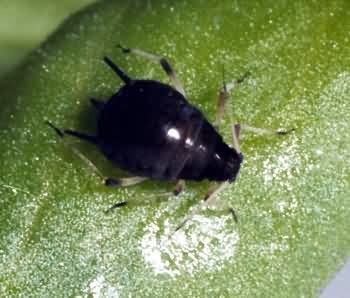Pests
Aphis fabae Scopoli - Black Bean Aphid.
Systematic position.
Class Insecta, order Homoptera, suborder Aphidinea, superfamily Aphidoidea, family Aphididae, subfamily Aphidinae, tribe Aphidini, subtribe Aphidina, genus Aphis.Biological group.
Polyphagous pest of agricultural crops.Morphology and biology.
Green-brown or black ovoid body of apterous female has wax pollination and big marginal tubercles on prothorax and on abdominal segments I and VII; body length varies from 1.8 to 2.5 mm. Legs and antenna are light yellow. Tail, siphunculi (2 times as long as fingerlike tail), and tarsi are brown-black. Black antenna is two thirds as long as body. Head and thorax of winged female are black and shiny, and abdomen is black-green. Oval eggs are black. The aphid life cycle includes two host plants. Over-wintering takes place during the egg phase, near the bud formations on fruit twigs of wahoo (Evonomus europaeus L., Evonomus verrucosa Scop.), snowball tree (Viburnum opulus L.) and jasmine (Philadelphus coronaries L.). Sexual agamous generations are present during the aphid life cycle. Larval period lasts 8-15 days. In the zone of greatest harm, the hatching of fundatrices larvae is observed in April. Life span of apterous parthenogenetic female is 45-52 days; its fecundity can be as many as 30 larvae. The pest feeds on leaves (prefers the upper side) and flower parts of first host, where it produces two generations. In the middle of May, the winged aphids migrate to second host (sugar beet, beans, haricot beans, vetch, potatoes, and others cultivated and wild plants). Migration lasts 8-15 days, depending on weather conditions. During this period, beet has 3-4 true leaves. The insect feeds on the lower side of leaves along the fibers, forming large colonies. The leaves bend, twist and dry; the crop yield decreases. When the plants become rough (beet, beans and others), the insects migrate to wild grasses (during the end of July). Viginoparae appear in the second third of August, and they migrate to first host plant. Reproduction takes place, and eggs are laid until the end of October. Female fecundity varies from 6 to 10 eggs.Distribution.
The insect is widespread throughout Western Europe, Asia, Africa, North and South America. Within the territory of the Former Soviet Union, the species occurs widely in the Northestern region of Russia, Siberia (from the Urals to Yenisei), the Altai, the Central Black Earth zone, Kazakhstan, Middle Asia, the Caucasus, Transcaucasia, Moldova, Byelorussia, Ukraine, and Baltic states. It is most harmful in the steppe and forest-steppe zones of Ukraine, Moldova, Central Black Earth zone, the Caucasus, and Transcaucasia.Ecology.
Embryonic development begins at the temperature of -5.5°C. Mortality of wintering eggs is not observed even at a temperature of -32°C; adults do not die even at the temperature of -5°C. Hatching of fundatrices larvae is observed at the temperature of 12-14°C (at the degree days 110°C). The aphids prefer warm and dry weather in April and May for their reproduction. Maximum aphid numbers are observed in July. Remigration of insects to first host takes place when there is an average daily air temperature of 18°C. The most favorable conditions for apterous females are temperatures of 20-25°C and relative humidity levels from 70-90%. Within the territory of the Former Soviet Union, the species produces up to 10-11 generations during a year. Most important predators include Coccinella septempunctata L., Coccinella quinquepunctata L., Adalia bipunctata L., Adalia decimpunctata L., Adonia variegate Goeze, Calvia quatuordecimpunctata L., Propylaea quatuordecimpunctata L., Exochomus quadripustulatus L., Thea vigintiduopunctata L., Sphaerophoria scripta L., Sphaerophoria menthastri L., Syrphus corollae F., Syrphus balteatus Deg., Scaeva pyrastri L., Chrysopa vulgaris Schn., Chrysopa perla L., Ephedrus plagiator Nees., and Aphidencyrtus aphidivorus Mayr.Economic significance.
The pest causes the greatest damage on vegetable and sugar beet, beans, haricot beans, potatoes, sunflower, and tomato. It causes harm to more than 200 species of cultivated and wild plants. Among wild plants, the insect prefers Papaver somniferum L., Arctium tomentonum Mill., Chenopodium album L., Atriplex rosea L., Marricaria recutita L., and Cirsium arvense L. Control measures include timely forecasting of the pest appearance and number, eradication of weeds, and insecticide treatments at the end of May and in June.Reference citations:
Asanov M.A. 1969. Black bean aphid in Gor'kov Region. Zashchita rastenii, 6: 25. (In Russian)Bondarenko A.A. 1981. Some peculiarities of black bean aphid ecology and ethology in Latvian SSR. In: Shcherbakov V.A., ed. Plant protection in Baltic republics and Byelorussia. V. 3. Vilnius: VASKHNIL. 10-12 p. (In Russian)
Gumovskaya G.N. 1988. Biological features of black bean aphid (Aphis fabae Scop.) for the Right-Bank Ukraine conditions. In: Zubenko V.F., ed. Proceedings of Sugar Beet Inst. Kiev: Sugar Beet Institute. 136-144 p. (In Russian)
Matov G.N. 1972. Biological features of black bean aphid (Aphis fabae Scop.) and its control in Moscow Region. In: Vavilov P.P., ed. Proceedings of Timiryazev Agricultural Academy 1. Moscow: Kolos. 166-175 p. (In Russian)
Mordvilko A.K. 1936. Black bean aphid Aphis fabae Scopoli. Zashchita rastenii, 10: 69-73. (In Russian)
Palii V.F. 1960. Black bean aphid (Aphis fabae Scop.) in the regions of sugar beet cultivation of Central Black Earth zone (RSFSR) and reasons of number fluctuations. Zoologicheskii zhurnal, 39(4): 534-539. (In Russian)
Razmadze K.S. 1962. About zonal spreading of Aphis fabae Scop. in Georgia. In: Kryshtal' A.F., ed. Ecological problems. V. 7. Moscow: Vysshaya shkola. 151 p. (In Russian)
Rupais A.A. 1964. Factors of black bean aphid mass appearance in the Latvian SSR conditions. In: Zinovskii Ya.P., ed. Forecasting in Plant Protection. Riga: AN Latvian SSR. 133-9 p. (In Russian)
Taran N.A. 1971. Places of black bean aphid wintering. In: Sapalev G.B., ed. Proceedings of Grodno Agricultural Institute. Gorki: Grodno Agricultural Institute. 120-121 p. (In Russian)
Veismann L. 1962. Forecasting methods for Aphis fabae Scop. and signaling of sugar beet treatments. In: Kryshtal' A.F., ed. Ecological problems. V. 7. Moscow: Vysshaya shkola. 24 p. (In Russian)


